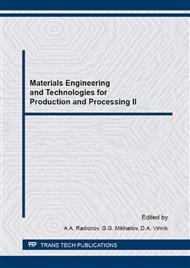[1]
S.P. Samoilov, A.O. Cherniavsky, Creep and long-term strength of molybdenum alloy, Materials Science Forum. 843 (2016) 28-33.
DOI: 10.4028/www.scientific.net/msf.843.28
Google Scholar
[2]
S.P. Samoilov, A.O. Cherniavsky, Molybdenum alloy long-term strength assessment, in: Proceeding of the International Conference on Industrial Engineering, Chelyabinsk. (2015) 105-109.
Google Scholar
[3]
A.N. Zelikman, Molybdenum, Metallurgizdat, Moscow, (1970).
Google Scholar
[4]
M. Xiao, F. Li, H. Xie, Y. Wang, Characterization of strengthening mechanism and hot deformation behavior of powder metallurgy molybdenum, Materials & Design. 34 (2012) 112-119.
DOI: 10.1016/j.matdes.2011.07.065
Google Scholar
[5]
B. Meng, M. Wan, X. Wu, Y. Zhou, Ch. Chang, Constitutive modeling for high-temperature tensile deformation behavior of pure molybdenum considering strain effects, Int. J. of Refractory Metals and Hard Materials. 45 (2014) 41-47.
DOI: 10.1016/j.ijrmhm.2014.03.005
Google Scholar
[6]
J.R. Ciulik, Creep and Dynamic Abnormal Grain Growth of Commercial-Purity Molybdenum: Ph.D. Diss., The University of Texas at Austin, (2005).
Google Scholar
[7]
J.B. Conway, P.N. Flagella, Creep-Rupture Data for the Refractory Metals to High Temperatures, Gordon and Breach Science Publishers, (1971).
Google Scholar
[8]
W.V. Green, M.C. Smith, D.M. Olson, Short-Time Creep-Rupture Behavior of Molybdenum at High Temperatures, Trans. AIME. 2215 (1959) 1061-1066.
Google Scholar
[9]
W.D. Klopp, W.R. Witzke, Mechanical Properties of Electron-Beam-Melted Molybdenum and Dilute Mo-Re Alloys, Met. Trans. 4 (1973) 2006-(2008).
DOI: 10.1007/bf02665440
Google Scholar
[10]
X.J. Yu, K.S. Kumar, Uniaxial, load-controlled cyclic deformation of recrystallized molybdenum sheet, Mat. Sc. and Engineering: A. 540 (2012) 187-197.
DOI: 10.1016/j.msea.2012.01.124
Google Scholar
[11]
D.G. Karpachev, E.D. Doronkin, S.A. Tsukerman, M.B. Taubkin, A.I. Knyazeva, L.I. Klestova, Refractory and rare metals and alloys: reference book, Metallurgiya, Moscow, (1977).
Google Scholar
[12]
T. Mrotzek, A. Hoffmann, U. Martin, Hardening mechanisms and recrystallization behavior of several molybdenum alloys, Int. J. of Refractory Metals and Hard Materials. 24 (2006) 298-305.
DOI: 10.1016/j.ijrmhm.2005.10.003
Google Scholar
[13]
D.A. Gokhfeld, L.B. Getsov, K.M. Kononov, E.T. Kulchikhin, Yu.N. Rebyakov, O.S. Sadakov, S.A. Timashev, V.N. Chepurskiy, Mechanical behavior of steels and alloys under unsteady loading: reference book, UrO RAN, Ekaterinburg, (1996).
Google Scholar
[14]
D.A. Gokhfeld, O.S. Sadakov, Plasticity and creep of structures under repeating loads, Mashinostroenie, Moscow, (1984).
Google Scholar
[15]
Z. Mróz, D. Weichert, S. Dorosz, Inelastic Behavior of Structures under Variable Loads, Kluwer Academic Publishers, Dordrecht-Boston-London, (1995).
DOI: 10.1007/978-94-011-0271-1
Google Scholar
[16]
N.A. Makhutov, K.V. Frolov, M.M. Gadenin, Scientific foundation of low-cycle strength enhancement, Nauka, Moscow, (2003).
Google Scholar
[17]
R. Kiran, K. Khandelwal, A micromechanical cyclic void growth model for ultra-low cycle fatigue, Int. J. of Fatigue. 70 (2015) 24-37.
DOI: 10.1016/j.ijfatigue.2014.08.010
Google Scholar
[18]
X. Martinez, S. Oller, L.G. Barbu, A.H. Barbat, A.M.P. de Jesus, Analysis of Ultra Low Cycle Fatigue problems with the Barcelona plastic damage model and a new isotropic hardening law, Int. J. of Fatigue. 73 (2015) 132-142.
DOI: 10.1016/j.ijfatigue.2014.11.013
Google Scholar


